Foraging Wild Food in Urban Spaces: The Contribution of Wild Foods to Urban Dietary Diversity in South Africa
Abstract
1. Introduction
2. Methods
2.1. Study Area
2.2. Data Collection
2.3. Dietary Diversity Score
2.4. Data Analysis
3. Results
3.1. Respondent Profile
3.2. Food Consumption Composition
Socio-Economic and Demographic Factors Influencing HDDS
3.3. Wild Foods
3.3.1. Patterns of Wild Food Consumption
3.3.2. The Contribution of Wild Foods to Household Dietary Diversity
3.4. Perceptions Towards Wild Foods
4. Discussion
4.1. Household Dietary Composition
Household Dietary Diversity
4.2. Wild Foods Consumption
4.2.1. The Contribution of Wild Foods to Household Dietary Diversity
4.2.2. Perceptions Towards Wild Foods
5. Conclusions
Author Contributions
Funding
Acknowledgments
Conflicts of Interest
References
- Walsh, C.M.; van Rooyen, F.C. Household food security and hunger in rural and urban communities in the Free State Province, South Africa. Ecol. Food Nutr. 2015, 54, 118–137. [Google Scholar] [CrossRef]
- Tevera, D.; Simelane, N. Urban food insecurity and social protection. In Rapid Urbanisation, Urban Food Deserts and Food Security in Africa; Crush, J., Battersby, J., Eds.; Springer International Publishing: Cham, Switzerland, 2016; pp. 157–168. [Google Scholar]
- Shaheen, S.; Ahmad, M.; Haroon, N. Edible Wild Plants: An Alternative Approach to Food Security; Springer International Publishing: Cham, Switzerland, 2017. [Google Scholar]
- FAO; IFAD; UNICEF; WFP; WHO. The state of food security and nutrition in the world 2019. In Safeguarding Against Economic Slowdowns and Downturns; Food and Agriculture Organization: Rome, Italy, 2019. [Google Scholar]
- STATS SA. Towards Measuring the Extent of Food Security in South Africa: An Examination of Hunger and Food Adequacy; Statistics South Africa: Pretoria, South Africa, 2019.
- Shisana, O.; Labadarios, D.; Rehle, T.; Simbayi, L.; Zuma, K.; Dhansay, A. SANHANES-1 Team. In South African National Health and Nutrition Examination Survey (SANHANES-1); HSRC Press: Cape Town, South Africa, 2013. [Google Scholar]
- FAO. The Future of Food and Agriculture—Trends and Challenges; Food and Agriculture Organization: Rome, Italy, 2017. [Google Scholar]
- Crush, J.; Frayne, G.B. Urban food insecurity and the new international food security agenda. Dev. South. Afr. 2011, 28, 527–544. [Google Scholar] [CrossRef]
- Kimani-Murage, E.W.; Schofield, L.; Wekesah, F.; Mohamed, S.; Mberu, B.; Ettarh, R.; Ezeh, A. Vulnerability to food insecurity in urban slums: Experiences from Nairobi, Kenya. J. Urban Health Bull. N. Y. Acad. Med. 2014, 91, 1098–1113. [Google Scholar] [CrossRef] [PubMed]
- Boonyabancha, S.; Kerr, T.; Joshi, L.; Tacoli, C. How the urban poor define and measure food security in Cambodia and Nepal. Environ. Urban. 2019, 31, 517–532. [Google Scholar] [CrossRef]
- Sneyd, L. Wild food consumption and urban food security. In Rapid Urbanisation, Urban Food Deserts and Food Security in Africa; Crush, J., Battersby, J., Eds.; Springer International Publishing: Cham, Switzerland, 2016; pp. 143–155. [Google Scholar]
- Crush, J.; Hovorka, A.; Terera, D. Urban Food Production and Household Food Security in Southern African Cities (No. 4); Queen’s University and AFSUN: Kingsto, Australia; Cape Town, South Africa, 2010. [Google Scholar]
- Zezza, A.; Tasciotti, L. Urban agriculture, poverty, and food security: Empirical evidence from a sample of developing countries. Food Secur. Policy 2010, 35, 265–273. [Google Scholar] [CrossRef]
- Korir, S.C.R.; Rotich, J.K.; Mining, P. Urban agriculture and food security in developing countries: A case study of Eldoret municipality, Kenya. Eur. J. Basic Appl. Sci. 2015, 2, 27–35. [Google Scholar]
- Siegner, A.; Sowerwine, J.; Acey, C. Does urban agriculture improve food security? Examining the nexus of food access and distribution of urban produced foods in the United States: A systematic review. Sustainability 2018, 10, 2988. [Google Scholar] [CrossRef]
- Tawodzera, G. Vulnerability in crisis: Urban household food insecurity in Epworth, Harare, Zimbabwe. Food Secur. 2011, 3, 503–520. [Google Scholar] [CrossRef]
- Burlingame, B. Wild nutrition. J. Food Compos. Anal. 2000, 13, 99–100. [Google Scholar] [CrossRef]
- Aberoumand, A. Nutritional evaluation of edible Portulaca oleracia as plant food. Food Anal. Methods 2009, 2, 204–207. [Google Scholar] [CrossRef]
- Chagomoka, T.; Drescher, A.; Glaser, R.; Marschner, B.; Nyandoro, G. Vegetable production, consumption and its contribution to diets along the urban-rural continuum in northern Ghana. Afr. J. Food Agric. Nutr. Dev. 2015, 15, 10352–10366. [Google Scholar]
- Bharucha, Z.; Pretty, J. The roles and values of wild foods in agricultural systems. Philos. Trans. R. Soc. B Biol. Sci. 2010, 365, 2913–2926. [Google Scholar] [CrossRef] [PubMed]
- Yang, R.Y.; Keding, G.B. Nutritional contributions of important African indigenous vegetables. In African Indigenous Vegetables in Urban Agriculture; Shackleton, C.M., Pasquini, M.W., Drescher, A.W., Eds.; Earthscan: London, UK, 2009; pp. 105–143. [Google Scholar]
- Legwaila, G.M.; Mojeremane, W.; Madisa, M.E.; Mmolotsi, R.M.; Rampart, M. Potential of traditional food plants in rural household food security in Botswana. J. Hortic. For. 2011, 3, 171–177. [Google Scholar]
- Stadlmayr, B.; Charrondière, U.R.; Eisenwagen, S.; Jamnadass, R.; Kehlenbeck, K. Nutrient composition of selected indigenous fruits from sub-Saharan Africa. J. Sci. Food Agric. 2013, 93, 2627–2636. [Google Scholar] [CrossRef]
- Smith, F.I.; Eyzaguirre, P. African leafy vegetables: Their role in the World Health Organization’s global fruit and vegetables initiative. Afr. J. Food Agric. Nutr. Dev. 2007, 7. Available online: https://www.ajfand.net/Volume7/No3/Smith-IPGRI1-1.pdf (accessed on 1 October 2019).
- Faber, M.; Witten, C.; Drimie, S. Community-based agricultural interventions in the context of food and nutrition security in South Africa. S. Afr. J. Clin. Nutr. 2011, 24, 21–30. [Google Scholar] [CrossRef]
- Ncube, K.; Shackleton, C.M.; Swallow, B.M.; Dassanayake, W. Impacts of HIV/AIDS on food consumption and wild food use in rural South Africa. Food Secur. 2016, 8, 1135–1151. [Google Scholar] [CrossRef]
- Shackleton, C.M.; Shackleton, S.E.; Buiten, E.; Bird, N. The importance of dry woodlands and forests in rural livelihoods and poverty alleviation in South Africa. For. Policy Econ. 2007, 9, 558–577. [Google Scholar] [CrossRef]
- Ohiokpehai, O. Promoting the nutritional goodness of traditional food products. Pak. J. Nutr. 2003, 2, 267–270. [Google Scholar]
- Shackleton, M.C.; Hurley, T.P.; Dahlberg, C.A.; Emery, R.M.; Nagendra, H. Urban foraging: A ubiquitous human practice overlooked by urban planners, policy, and research. Sustainability 2017, 9, 1884. [Google Scholar] [CrossRef]
- Poe, M.R.; McLain, R.J.; Emery, M.; Hurley, P.T. Urban forest justice and the rights to wild foods, medicines, and materials in the city. Hum. Ecol. 2013, 41, 409–422. [Google Scholar] [CrossRef]
- Mollee, E.; Pouliot, M.; McDonald, M.A. Into the urban wild: Collection of wild urban plants for food and medicine in Kampala, Uganda. Land Use Policy 2017, 63, 67–77. [Google Scholar] [CrossRef]
- Synk, C.M.; Kim, B.F.; Davis, C.A.; Harding, J.; Rogers, V.; Hurley, P.T.; Nachman, K.E. Gathering Baltimore’s bounty: Characterizing behaviors, motivations, and barriers of foragers in an urban ecosystem. Urban For. Urban Green 2017, 28, 97–102. [Google Scholar] [CrossRef]
- Stark, P.B.; Miller, D.; Carlson, T.J.; de Vasquez, K.R. Open-source food: Nutrition, toxicology, and availability of wild edible greens in the East Bay. PLoS ONE 2019, 14. [Google Scholar] [CrossRef] [PubMed]
- Chakona, G.; Shackleton, C.M. Food insecurity in South Africa: To what extent can social grants and consumption of wild foods eradicate hunger? World Dev. Perspect. 2019, 13, 87–94. [Google Scholar] [CrossRef]
- Slater, R.; Twyman, C. Hidden livelihoods? In Natural Resource-Dependent Livelihoods and Urban Development Policy; Overseas Development Institute: London, UK, 2003. [Google Scholar]
- STATS SA. Statistics by place-Thabazimbi; Statistics South Africa: Pretoria, South Africa, 2011. Available online: http://www.statssa.gov.za/?page_id=4286&id=13271 (accessed on 12 January 2018).
- Tlokwe City Council. Integrated Development Plan of the Tlokwe City Council Third Generation IDP; Tlokwe City Council: Potchefstroom, South Africa, 2012. [Google Scholar]
- STATS SA. Census 2011 Provincial Profile: Limpopo; Statistics South Africa: Pretoria, South Africa, 2014. Available online: http://www.statssa.gov.za/publications/Report-03-01-78/Report-03-01-782011.pdf (accessed on 12 January 2018).
- STATS SA. Poverty Trends in South Africa: An Examination of Absolute Poverty between 2006 and 2015; Statistics South Africa: Pretoria, South Africa, 2017.
- Thabazimbi Local Municipality. Integrated Development Plan; Thabazimbi Local Municipality: Thabazimbi, South Africa, 2016. [Google Scholar]
- Mucina, L.; Rutherford, M.C. The Vegetation of South Africa, Lesotho and Swaziland; South African National Biodiversity Institute: Pretoria, South Africa, 2006. [Google Scholar]
- Kaoma, H.; Shackleton, C.M. The direct-use value of urban tree non-timber forest products to household income in poorer suburbs in South African towns. For. Policy Econ. 2015, 61, 104–112. [Google Scholar] [CrossRef]
- FAO. Guidelines for Measuring Household and Individual Dietary Diversity; Food and Agriculture Organization: Rome, Italy, 2010. [Google Scholar]
- FAO. Report on Use of the Household Food Insecurity Access Scale and Household Dietary Diversity Score in Two Survey Rounds in Manica and Sofala Provinces, Mozambique, 2006–2007; Food and Agriculture Organization: Rome, Italy, 2008. [Google Scholar]
- Faber, M.; Oelofse, A.; Van Jaarsveld, P.J.; Wenhold, F.A.M.; Jansen van Rensburg, W.S. African leafy vegetables consumed by households in the Limpopo and KwaZulu-Natal. S. Afr. J. Clin. Nutr. 2010, 23, 30–38. [Google Scholar] [CrossRef]
- Crush, J.; Caesar, M. City without choice: Urban food insecurity in Msunduzi, South Africa. Urban Forum. 2014, 2, 165–175. [Google Scholar] [CrossRef]
- Ronquest-Ross, L.C.; Vink, N.; Sigge, G. Food consumption changes in South Africa since 1994. S. Afr. J. Sci. 2015, 111. [Google Scholar] [CrossRef]
- Chakona, G.; Shackleton, C.M. Minimum dietary diversity scores for women indicate micronutrient adequacy and food insecurity status in South African towns. Nutrients 2017, 9, 812. [Google Scholar] [CrossRef]
- Kasimba, S.N.; Motswagole, B.S.; Covic, N.M.; Claasen, N. Household access to traditional and indigenous foods positively associated with food security and dietary diversity in Botswana. Public Health Nutr. 2018, 21, 1200–1208. [Google Scholar] [CrossRef] [PubMed]
- Mekuria, G.; Wubneh, Y.; Tewabe, T. Household dietary diversity and associated factors among residents of finote selam town, north west Ethiopia: A cross sectional study. BMC Nutr. 2017, 3. [Google Scholar] [CrossRef]
- Chagomoka, T.; Unger, S.; Drescher, A.; Glaser, R.; Marschner, B.; Schlesinger, J. Food coping strategies in northern Ghana. A socio-spatial analysis along the urban-rural continuum. Agric. Food Secur. 2016, 5. [Google Scholar] [CrossRef]
- Chakona, G.; Shackleton, C.M. Household food insecurity along an agro-ecological gradient influences children’s nutritional status in South Africa. Front. Nutr. 2018, 4. [Google Scholar] [CrossRef] [PubMed]
- Cohen, M.J.; Garrett, J.L. The food price crisis and urban food (in)security. Environ. Urban. 2010, 22, 467–482. [Google Scholar] [CrossRef]
- Poulain, J.P.; Smith, W.; Laporte, C.; Tibère, L.; Ismail, M.N.; Mognard, E.; Baharuddin, A.S. Studying the Consequences of Modernization on Ethnic Food Patterns: Development of the Malaysian Food Barometer (MFB). Anthropology of Food. 2015. Available online: http://aof.revues.org/7735 (accessed on 1 October 2019).
- Tefera, B.; Tilahun, Y. Dietary diversity among people 40 years and above in Jimma Town, Southwest Ethiopia. Ethiop. J. Health Sci. 2007, 17, 115–120. [Google Scholar]
- Drimie, S.; Faber, M.; Vearey, J.; Nunez, L. Dietary diversity of formal and informal residents in Johannesburg, South Africa. BMC Public Health 2013, 13. [Google Scholar] [CrossRef]
- Gebre, G.G. Determinants of food insecurity among households in Addis Ababa city, Ethiopia. Interdiscip. Descr. Complex Syst. 2012, 10, 159–173. [Google Scholar] [CrossRef]
- Muzah, O. An Assessment of Household food Security in urban and Peri-Urban Areas; a Case Study of Bindura municipal Area, Mashonaland central, Zimbabwe. Master’s Thesis, University of KwaZulu-Natal, Pietermaritzburg, South Africa, 2015. [Google Scholar]
- Powell, B.; Bezner-Kerr, R.; Young, S.L.; Johns, T. The determinants of dietary diversity and nutrition: Ethnonutrition knowledge of local people in the East Usambara Mountains, Tanzania. J. Ethnobiol. Ethnomedicine 2017, 13. [Google Scholar] [CrossRef]
- Khed, V. Nutritional Status and Dietary Diversity of Households in Vijayapura District of Karnataka. In Proceedings of the 30th International Conference of Agricultural Economists, Vancouver, BC, Canada, 28 July–2 August 2018; pp. 1–23. Available online: http://ageconsearch.umn.edu/record/275911/files/2500.pdf (accessed on 1 October 2019).
- Ecker, O.; Breisinger, C. The Food Security System: A new Conceptual Framework; IFPRI Discussion Paper 1166; International Food Policy Research Institute (IFPRI): Washington, DC, USA, 2012. [Google Scholar]
- Paumgarten, F.; Locatelli, B.; Witkowski, E.T.F. Wild foods: Safety net or poverty trap? A South African case study. Hum. Ecol. 2018, 46, 183–195. [Google Scholar] [CrossRef]
- Gido, E.O.; Ayuya, O.I.; Owuor, G.; Bokelmann, W. Consumption intensity of leafy African indigenous vegetables: Towards enhancing nutritional security in rural and urban dwellers in Kenya. Agric. Food Econ. 2017, 5. [Google Scholar] [CrossRef]
- Powell, B.; Thilsted, S.H.; Ickowitz, A.; Termote, C.; Sunderland, T.; Herforth, A. Improving diets with wild and cultivated biodiversity from across the landscape. Food Secur. 2015, 7, 535–554. [Google Scholar] [CrossRef]
- Fungo, R.; Muyonga, J.; Kabahenda, M.; Kaaya, A.; Okia, C.A.; Donn, P.; Snook, L. Contribution of forest foods to dietary intake and their association with household food insecurity: A cross-sectional study in women from rural Cameroon. Public Health Nutr. 2016, 19, 3185–3196. [Google Scholar] [CrossRef] [PubMed]
- Maseko, H.; Shackleton, C.M.; Nagoli, J.; Pullanikkatil, D. Children and wild foods in the context of deforestation in rural Malawi. Hum. Ecol. 2017, 45, 795–807. [Google Scholar] [CrossRef]
- Luna-González, D.V.; Sørensen, M. Higher agrobiodiversity is associated with improved dietary diversity, but not child anthropometric status, of Mayan Achí people of Guatemala. Public Health Nutr. 2018, 21, 2128–2141. [Google Scholar] [CrossRef]
- Chen, B.; Qiu, Z. Consumers’ attitudes towards edible wild plants: A case study of Noto Peninsula, Ishikawa Prefecture, Japan. Int. J. For. Res. 2012. [Google Scholar] [CrossRef]
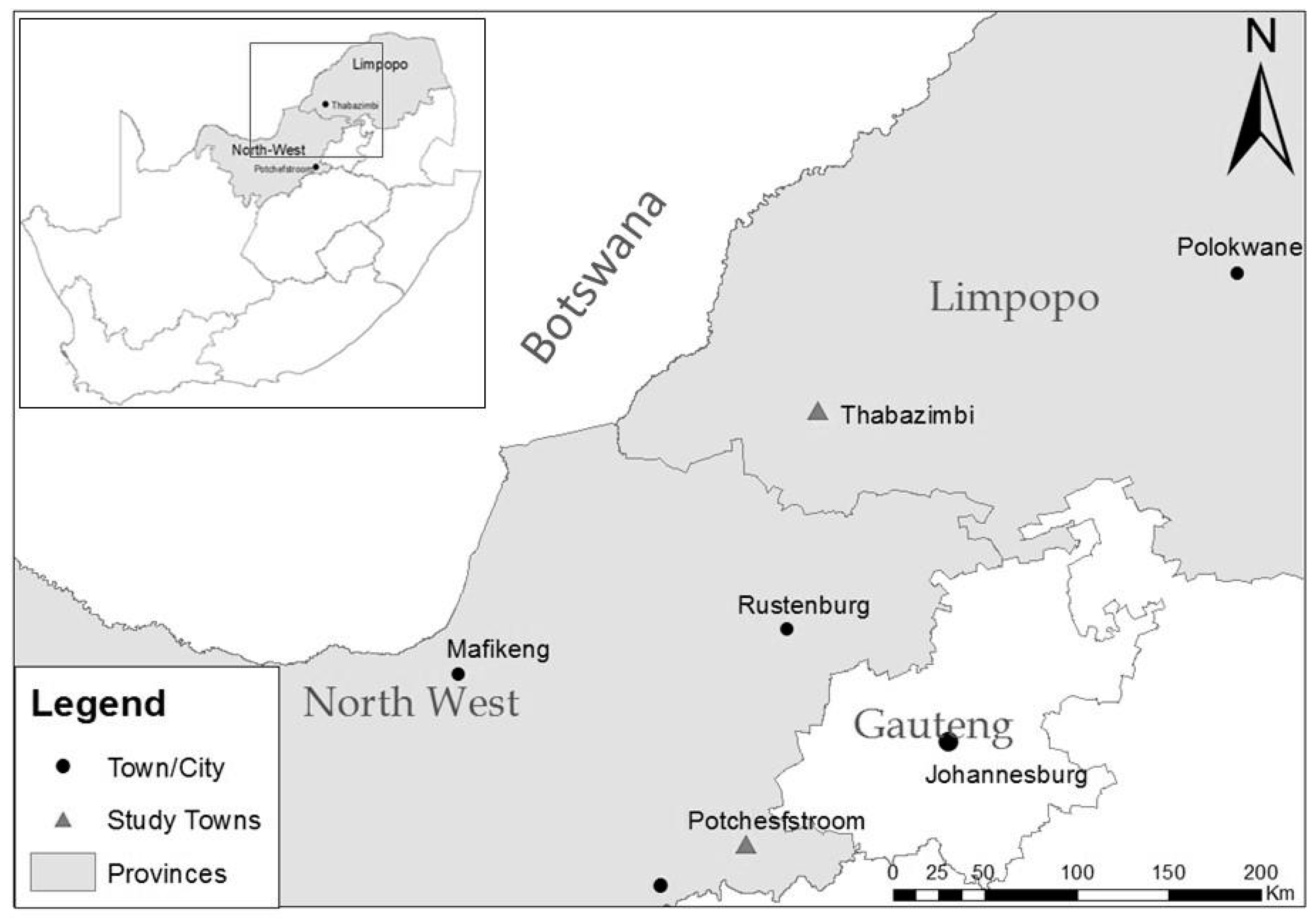
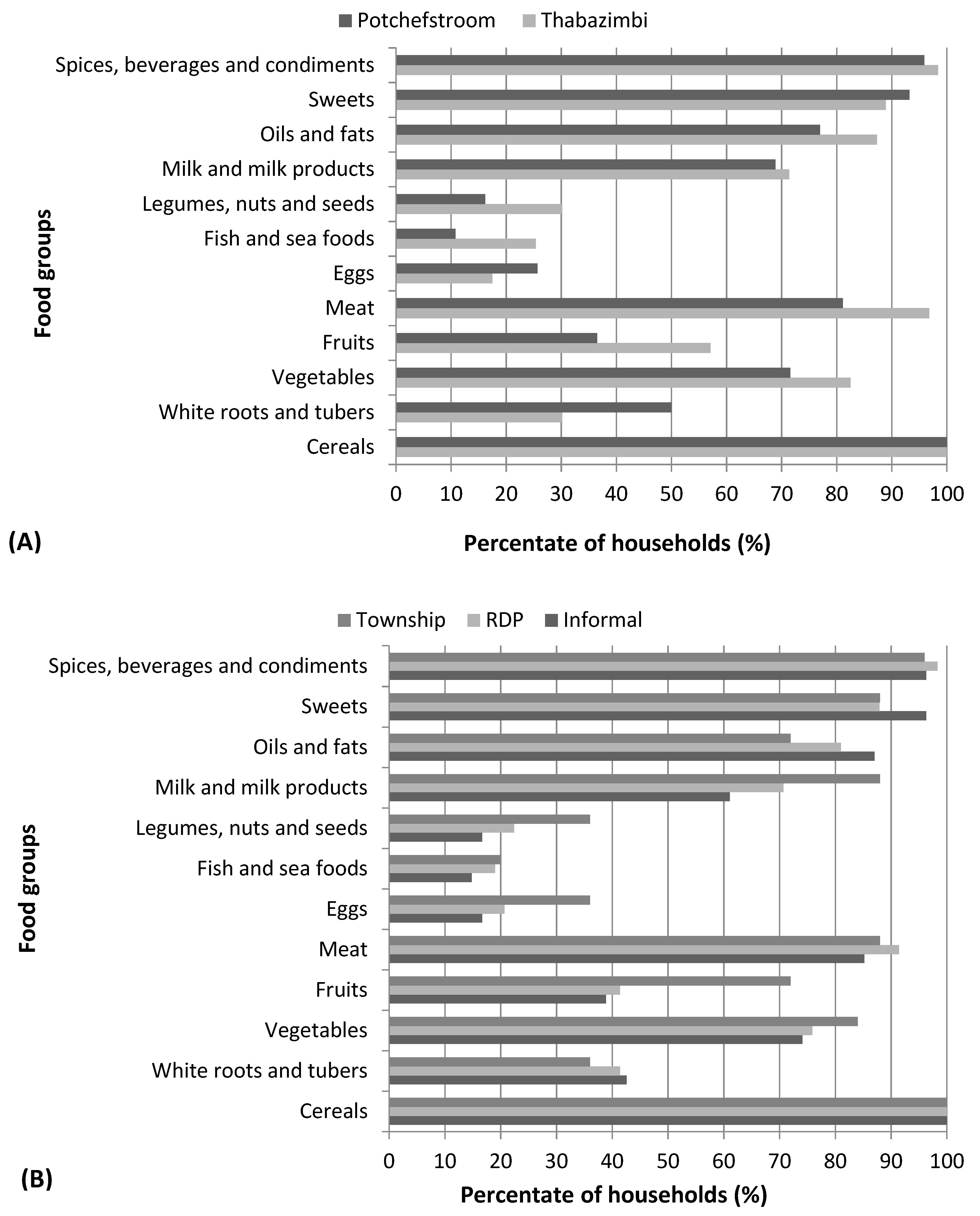
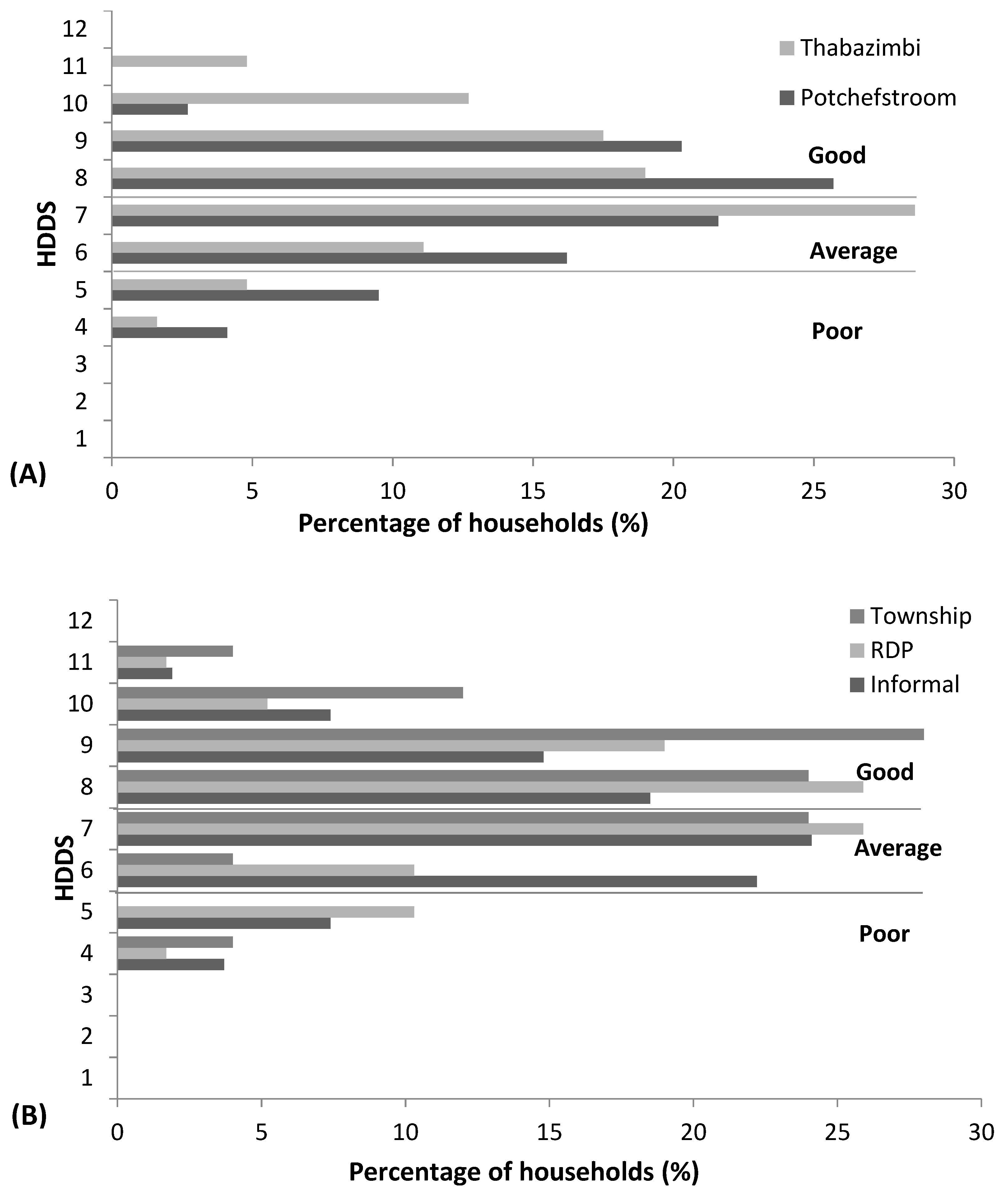

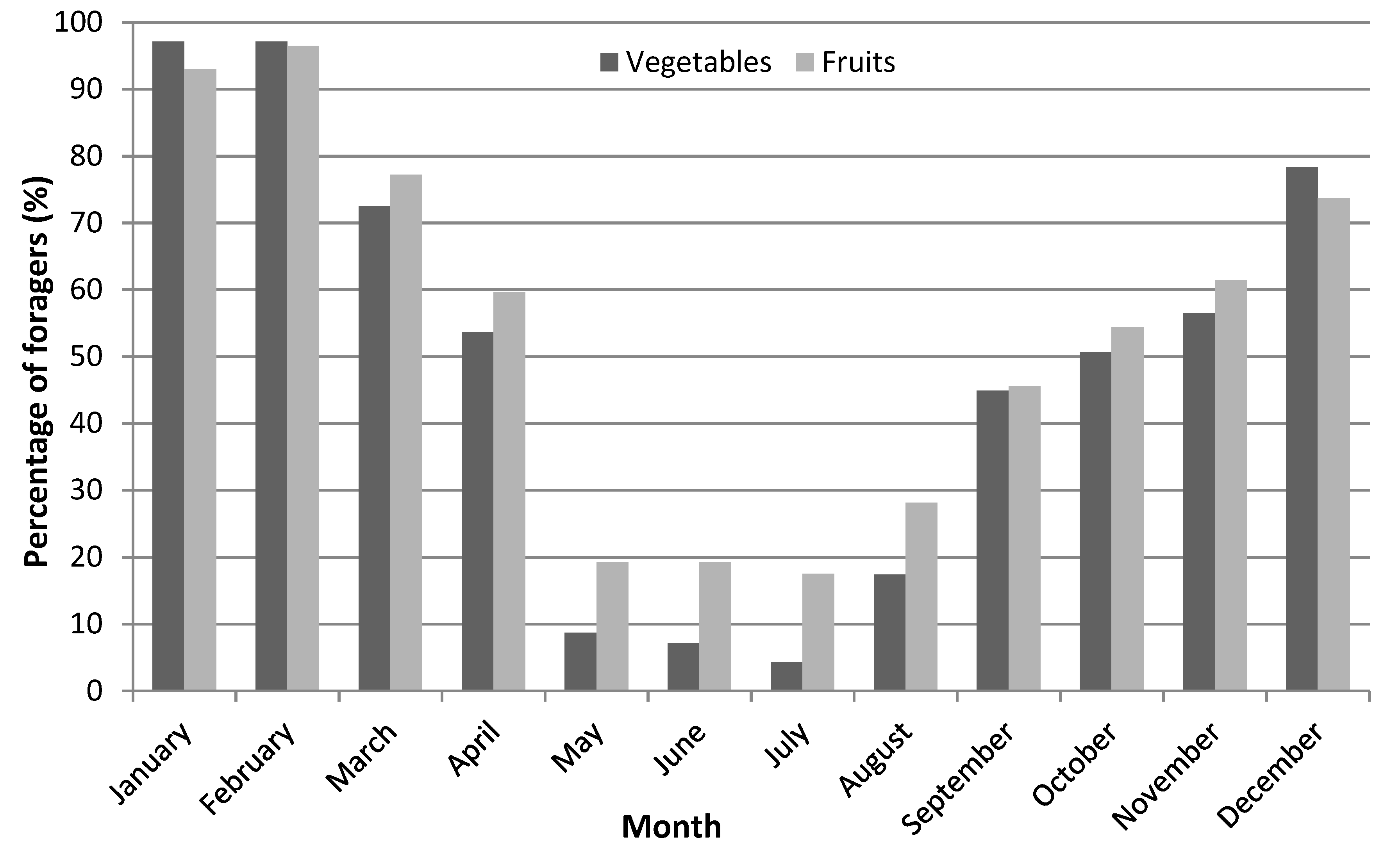
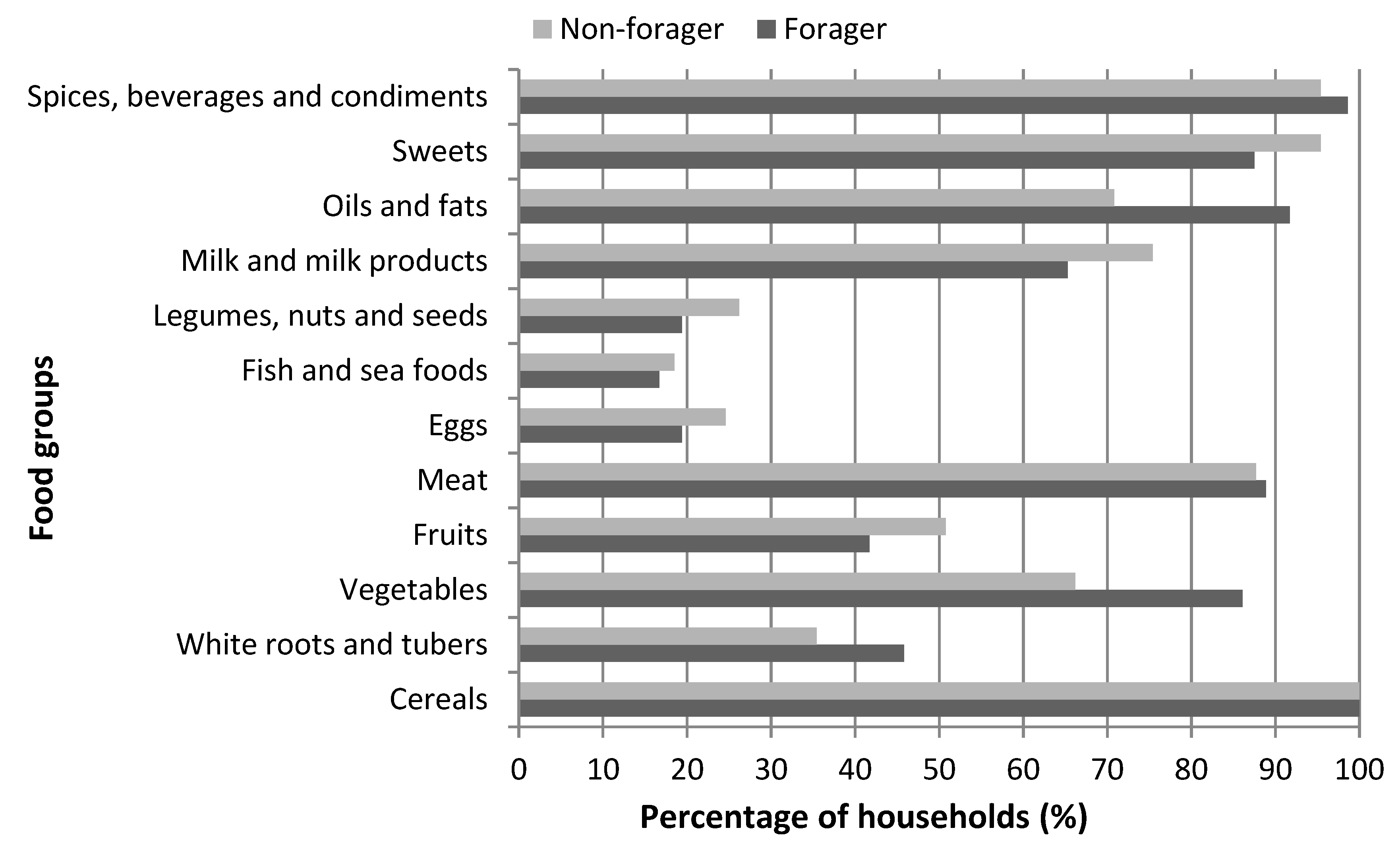
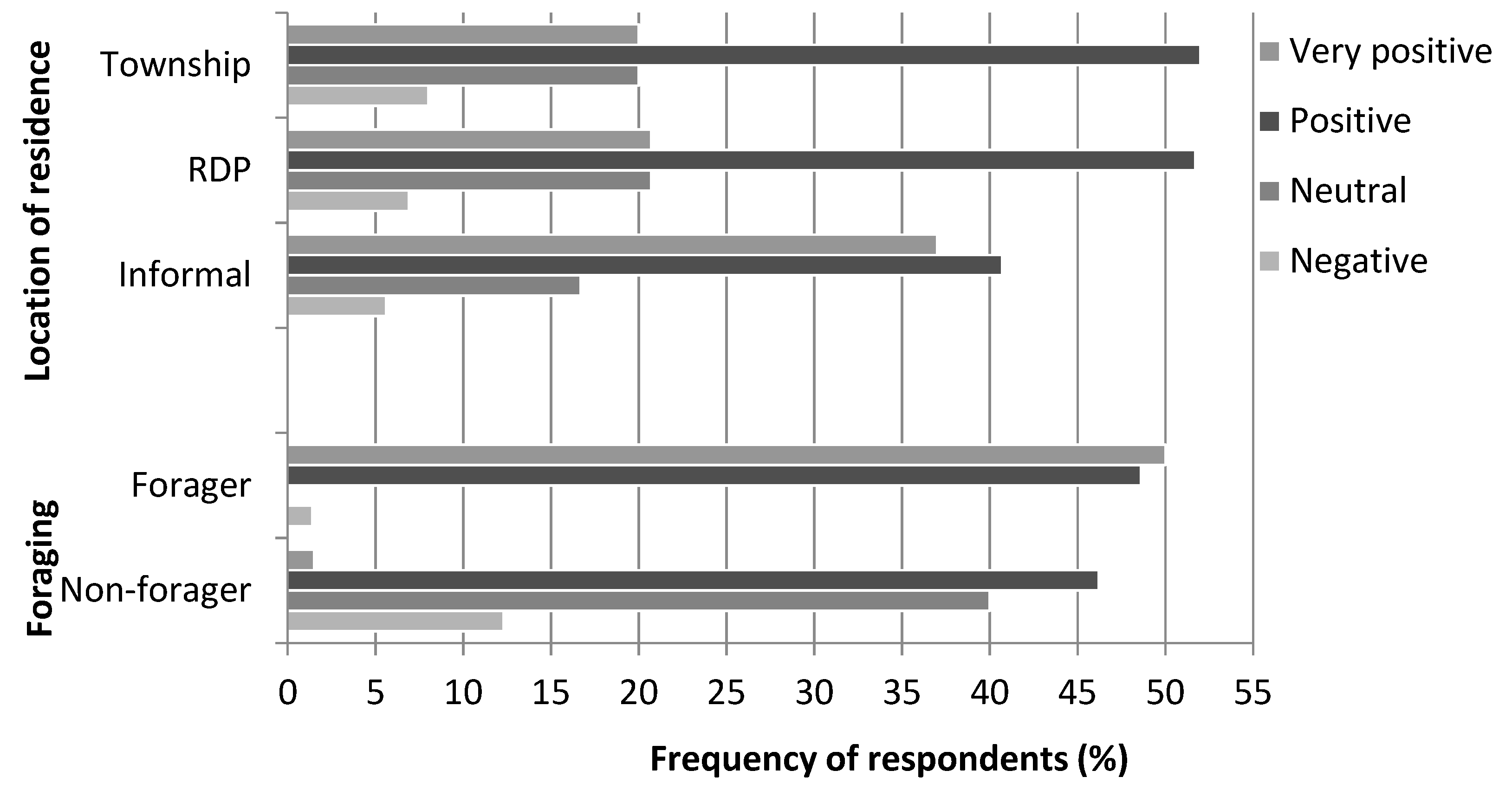
| Variable | Category | Value (%) |
|---|---|---|
| Sex | Male | 41 (29.9) |
| Female | 96 (70.1) | |
| Age (Years) | Mean ± SD | 45.5 ± 13.8 |
| Education | None | 15 (11.3) |
| Primary | 32 (24.1) | |
| Secondary | 77 (57.9) | |
| Tertiary | 9 (6.8) | |
| Employment | Full-time | 31 (22.6) |
| Part-time | 19 (13.9) | |
| Self | 7 (5.1) | |
| Unemployed | 63 (46.0) | |
| Retired | 14 (10.2) | |
| Other | 3 (2.2) | |
| Household size | Mean ± SD | 4.4 ± 2.4 |
| Residence | Informal | 54 (39.4) |
| RDP | 58 (42.3) | |
| Township | 25 (18.2) | |
| Length of residence (years) | Mean ± SD | 25.8±14.5 |
| Childhood | Farm | 36 (26.3) |
| Rural village | 62 (45.3) | |
| Township | 37 (27.0) | |
| Inner town | 2 (1.5) | |
| Childhood foraging background | Yes | 126 (92.0) |
| No | 11 (8.0) | |
| Household income | Low | 66 (49.3) |
| Average | 49 (36.6) | |
| High | 19 (14.2) | |
| Proportion of income on food | <20% | 26 (19.3) |
| 21–50% | 45 (33.3) | |
| 51–80% | 46 (34.1) | |
| 81–100% | 18 (13.3) | |
| Wealth index | Mean ± SD | 1.46 ± 0.86 |
| Variables | Coefficient | p |
|---|---|---|
| Sex | 0.03 | 0.80 |
| Age | −0.004 | 0.53 |
| Household size | −0.05 | 0.11 |
| Social grants | 0.13 | 0.40 |
| Household Income (Low) | 0.17 | 0.10 |
| Household income (Better) | 0.31 | 0.24 |
| Food income (11–20%) | 0.53 | 0.29 |
| Food income (21–50%) | 0.49 | 0.32 |
| Food income (51–80%) | 0.59 | 0.23 |
| Food income (81–90%) | 0.68 | 0.19 |
| Food income (91–100%) | 0.63 | 0.29 |
| Wealth index | 0.20 | 0.02 |
| Education | 0.27 | 0.01 |
| Employment (Retired) | 0.30 | 0.55 |
| Employment (Unemployed) | 0.27 | 0.09 |
| Employment (Other) | 0.25 | 0.30 |
| Employment (Self-employed) | 0.44 | 0.14 |
| Employment (Part-time) | 0.34 | 0.08 |
| Domain | Item | SD | D | N | A | SA | DK |
|---|---|---|---|---|---|---|---|
| Affective (Feelings, emotive) | Wild foods are delicious | 2.2 | 5.1 | 4.4 | 19.7 | 65.0 | 3.6 |
| Wild foods are tasteless | 71.5 | 10.2 | 6.6 | 5.8 | 2.9 | 2.9 | |
| I feel ashamed to eat wild foods | 78.1 | 14.6 | 2.9 | 2.2 | 2.2 | ||
| Wild foods are contaminated | 28.5 | 13.9 | 10.9 | 24.1 | 12.4 | 10.2 | |
| Wild foods are collected freely | 3.6 | 7.3 | 5.8 | 20.4 | 54.0 | 8.8 | |
| Cognitive (Beliefs) | Wild foods are nutritious | 2.9 | 2.9 | 8.8 | 17.5 | 65.0 | 2.9 |
| Wild foods are important to health | 2.2 | 1.5 | 8.0 | 16.8 | 67.2 | 4.4 | |
| Wild foods are consumed by everyone | 2.9 | 13.9 | 2.9 | 16.1 | 62.0 | 2.2 | |
| Wild foods acts as safety net during times of emergency and shocks | 1.5 | 4.4 | 11.7 | 16.8 | 62.0 | 3.6 | |
| Wild foods are important in diversifying diets | 2.2 | 0.7 | 11.7 | 40.9 | 38.7 | 5.8 | |
| Wild foods are part of cultural identity | 2.9 | 4.4 | 7.3 | 21.2 | 63.5 | 0.7 | |
| Behavioural (Actions) | Wild foods are easy to find | 30.7 | 16.1 | 2.9 | 30.7 | 16.1 | 3.6 |
| Use of wild foods is declining | 25.5 | 11.7 | 4.4 | 38.7 | 16.1 | 3.6 | |
| Wild foods are foods for children | 64.2 | 20.4 | 2.2 | 12.4 | 0.7 | ||
| Wild foods are foods for the poor | 67.9 | 12.4 | 8.8 | 8.0 | 2.9 |
© 2020 by the authors. Licensee MDPI, Basel, Switzerland. This article is an open access article distributed under the terms and conditions of the Creative Commons Attribution (CC BY) license (http://creativecommons.org/licenses/by/4.0/).
Share and Cite
Garekae, H.; Shackleton, C.M. Foraging Wild Food in Urban Spaces: The Contribution of Wild Foods to Urban Dietary Diversity in South Africa. Sustainability 2020, 12, 678. https://doi.org/10.3390/su12020678
Garekae H, Shackleton CM. Foraging Wild Food in Urban Spaces: The Contribution of Wild Foods to Urban Dietary Diversity in South Africa. Sustainability. 2020; 12(2):678. https://doi.org/10.3390/su12020678
Chicago/Turabian StyleGarekae, Hesekia, and Charlie M. Shackleton. 2020. "Foraging Wild Food in Urban Spaces: The Contribution of Wild Foods to Urban Dietary Diversity in South Africa" Sustainability 12, no. 2: 678. https://doi.org/10.3390/su12020678
APA StyleGarekae, H., & Shackleton, C. M. (2020). Foraging Wild Food in Urban Spaces: The Contribution of Wild Foods to Urban Dietary Diversity in South Africa. Sustainability, 12(2), 678. https://doi.org/10.3390/su12020678






